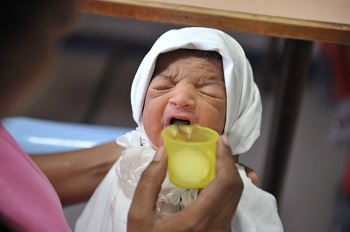7,000 newborns die every day, despite steady decrease in under-five mortality, new report says
At current trends, 30 million newborns will die within first 28 days of life between 2017 and 2030
Every day in 2016, 15,000 children died before their fifth birthday, 46 per cent of them – or 7,000 babies – died in the first 28 days of life, according to a new UN report.

A newborn is fed donor milk by a nurse at the Special Newborn Care Unit (SNCU) at the Government hospital in Nalgonda District. Telangana State, India.
Levels and Trends in Child Mortality 2017, reveals that although the number of children dying before the age of five is at a new low– 5.6 million in 2016, compared with nearly 9.9 million in 2000 – the proportion of under-five deaths in the newborn period has increased from 41 per cent to 46 per cent during the same period.
“The lives of 50 million children under-five have been saved since 2000, a testament to the serious commitment by governments and development partners to tackle preventable child deaths,” said UNICEF Chief of Health, Stefan Swartling Peterson. “But unless we do more to stop babies from dying the day they are born, or days after their birth, this progress will remain incomplete. We have the knowledge and technologies that are required – we just need to take them where they are most needed.”
At current trends, 60 million children will die before their fifth birthday between 2017 and 2030, half of them newborns, according to the report released by UNICEF, the World Health Organization, the World Bank and the Population Division of UNDESA which make up the Inter-agency Group for Child Mortality Estimation (IGME)
Most newborn deaths occurred in two regions: Southern Asia (39 per cent) and sub-Saharan Africa (38 per cent). Five countries accounted for half of all new-born deaths: India (24 per cent), Pakistan (10 per cent), Nigeria (9 per cent), the Democratic Republic of the Congo (4 per cent) and Ethiopia (3 per cent).
“To achieve universal health coverage and ensure more newborns survive and thrive, we must serve marginalized families," says Dr Flavia Bustreo, Assistant Director-General for Family, Women’s and Children’s Health at WHO. "To prevent illness, families require financial power, their voices to be heard and access to quality care. Improving quality of services and timely care during and after childbirth must be prioritized.”
The report notes that many lives can be saved if global inequities are reduced. If all countries achieved the average mortality of high-income countries, 87 per cent of under-five deaths could have been averted and almost 5 million lives could have been saved in 2016.
“It is unconscionable that in 2017, pregnancy and child birth are still life-threatening conditions for women, and that 7,000 newborns die daily,” said Tim Evans, Senior Director of Health Nutrition and Population at the World Bank Group. “The best measure of success for Universal Health Coverage is that every mother should not only be able to access health care easily, but that it should be quality, affordable care that will ensure a healthy and productive life for her children and family. We are committed to scaling up our financing to support country demand in this area, including through innovative mechanisms like the Global Financing Facility (GFF). ”
Pneumonia and diarrhea top the list of infectious diseases which claim the lives of millions of children under-five globally, accounting for 16 per cent and 8 per cent of deaths, respectively. Preterm birth complications and complications during labour or child birth were the causes of 30 per cent of newborn deaths in 2016. In addition to the 5.6 million under-5 deaths, 2.6 million babies are stillborn each year, the majority of which could be prevented.
Ending preventable child deaths can be achieved by improving access to skilled health-professionals during pregnancy and at the time of birth; lifesaving interventions, such as immunization, breastfeeding and inexpensive medicines; and increasing access to water and sanitation, that are currently beyond the reach of the world’s poorest communities.
For the first time, mortality data for older children age 5 to 14 was included in the report, capturing other causes of death such as accidents and injuries. Approximately 1 million children aged 5 to 14 died in 2016.
“This new report highlights the remarkable progress since 2000 in reducing mortality among children under age 5,” said UN Under-Secretary-General for Economic and Social Affairs Mr. LIU Zhenmin. “Despite this progress, large disparities in child survival still exist across regions and countries, especially in sub-Saharan Africa. Yet many deaths at these ages are easily preventable through simple, cost-effective interventions administered before, during and immediately after birth. Reducing inequities and reaching the most vulnerable newborns, children and mothers are essential for achieving the SDG target on ending preventable childhood deaths and for ensuring that no one will be left behind.”
The report also notes that:
• In sub-Saharan Africa, estimates show that 1 child in 36 dies in the first month, while in the world’s high income countries, the ratio is 1 in 333.
• Unless the rate of progress improves, more than 60 countries will miss the UN Sustainable Development Goal (SDG) to end preventable deaths of newborns by 2030 and half would not meet the target of 12 neonatal deaths per 1,000 live births by 2050. These countries account for about 80 per cent of neonatal deaths in 2016.
Source:United Nations Children's Fund
- 247 reads
Human Rights
Ringing FOWPAL’s Peace Bell for the World:Nobel Peace Prize Laureates’ Visions and Actions

Protecting the World’s Cultural Diversity for a Sustainable Future

The Peace Bell Resonates at the 27th Eurasian Economic Summit

Declaration of World Day of the Power of Hope Endorsed by People in 158 Nations

Puppet Show I International Friendship Day 2020

